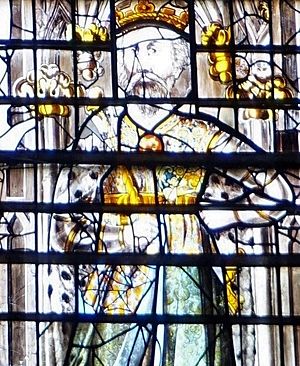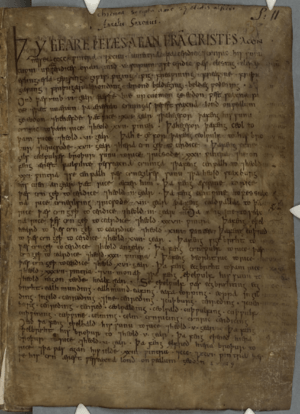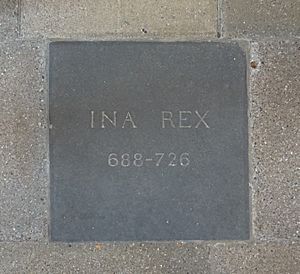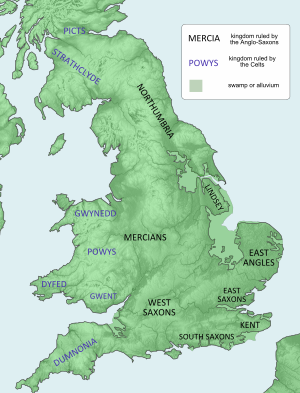Ine of Wessex facts for kids
Quick facts for kids Ine |
|
|---|---|

King Ine depicted in the Transfiguration Window of Wells Cathedral.
|
|
| King of Wessex | |
| Reign | 689–726 |
| Predecessor | Cædwalla |
| Successor | Æthelheard |
| Born | c. 670 |
| Died | After 726 Rome |
| Spouse | Æthelburg of Wessex |
| House | Wessex |
| Father | Cenred |
Ine, also known as Ini or Ina, was a powerful King of Wessex from 689 to 726 AD. His kingdom was a major force in southern England when he became king. Even though he couldn't keep all the lands his predecessor, Cædwalla, had gained, Ine still controlled a large area. He especially strengthened Wessex's power in the western part of England.
King Ine is famous for his code of laws, created around 694. These were the first laws made by an Anglo-Saxon king outside of Kent. They teach us a lot about society back then and show Ine's strong Christian beliefs. Trade grew a lot during his time, and the town of Hamwic (now Southampton) became a very important trading port. It's also thought that Wessex started making its own coins during Ine's reign.
In 726, Ine decided to give up his throne and travel to Rome. He left the kingdom to "younger men," as the writer Bede noted. His successor was Æthelheard.
Contents
Who Was King Ine?
Ine was born around 670 AD. His father was Cenred. Ine had a brother named Ingild and two sisters, Cuthburh and Cwenburg. His sister Cuthburh married King Aldfrith of Northumbria. Ine himself was married to Æthelburg. The historian Bede said Ine was "of the blood royal," meaning he belonged to the royal family of the Gewisse, an early name for the West Saxons.
We learn about Ine's family from old writings like the Anglo-Saxon Chronicle. This book was written much later, in the late 800s. It helps us understand the kings of Wessex.
Ine's predecessor, Cædwalla, gave up his throne in 688 to go to Rome. Ine became king in 689. This short gap might mean there was some unrest before Ine took over. Ine's laws mention his father, Cenred, helping him. This suggests Cenred might have ruled alongside Ine for a while.
Ine's Reign and Kingdom
At the start of Ine's rule, Wessex controlled a large area. This included the upper Thames valley. His kingdom stretched west towards the Bristol Channel. The West Saxons had pushed back the British kingdom of Dumnonia (modern Devon and Cornwall). To the east, Wessex bordered the East Saxons, and to the southeast were the South Saxons and Kent.
Ine kept control of the Isle of Wight. He also made progress in Dumnonia. However, some lands that Cædwalla had gained in Sussex, Surrey, and Kent were lost by the end of Ine's reign.
Relations with Other Kingdoms
In 694, Ine made peace with Kent. Kent's king, Wihtred, paid Ine a large sum of money. This payment was to make up for the death of Cædwalla's brother, Mul. Mul had been killed during a rebellion in Kent in 687.
Ine kept the South Saxons under his control for some time. King Nothhelm of Sussex was even called a relative of Ine. In 710, Nothhelm fought alongside Ine against Dumnonia. This shows Sussex was still under Wessex's power then.
Control of Surrey often changed hands between different kingdoms. Ine's laws suggest he controlled Surrey early on. However, by 704, Surrey was no longer under West Saxon rule. Ine had disputes with the East Saxons because they were sheltering people exiled from Wessex.
Bede wrote that Ine controlled Sussex for "several years." But in 722, an exile named Ealdberht fled to Surrey and Sussex. Ine invaded Sussex because of this. Three years later, Ine invaded again and killed Ealdberht. This shows Sussex had become independent from Wessex.
Battles and Borders
In 710, Ine and Nothhelm fought against Geraint of Dumnonia. Some records say Geraint was killed in this battle. It's believed Ine's army gained control of what is now Devon. The new border was likely the river Tamar. However, other records suggest the Britons won a battle in 722. This battle was against Ine's forces, but its exact location is unknown.
Ine fought a battle at Woden's Barrow in 715. It's not clear if he fought against the Mercians or with them. The outcome of this battle is also unknown. Ine did control the southern bank of the Thames. A document from 687 shows him giving land near the Thames to the church.
In 721, Ine killed a man named Cynewulf. His name suggests he might have been related to the Wessex royal family. A year later, Ine's queen, Æthelburg, destroyed Taunton. Ine had built Taunton earlier in his reign, around 710. The reason for this destruction is not known.
Life in Wessex Under Ine
During Ine's reign, we see the first mentions of "ealdormans" in Wessex. These were important officials who led different areas, similar to modern counties. Ine might have divided Wessex into areas like Hampshire, Wiltshire, Somerset, Devon, and Dorset.
Around 710, a trading town called Hamwic grew on the River Itchen. This site is now part of Southampton. Goods like glass, animal hides, and pottery were traded there. Coins from other places, like Frisia, have been found. This shows Hamwic was a busy international port. Ine likely supported Hamwic because it brought in valuable goods and needed royal protection. The town may have had a population of 5,000 people. This large number suggests the king's involvement in feeding and housing them.
Trade increased after 700. The use of "sceat" coins became common. It's believed that Wessex started making its own coins during Ine's time. However, no coins with Ine's name on them have been found.
Ine's Laws

Ine's laws are some of the oldest Anglo-Saxon laws we have. The first Anglo-Saxon law code was from Æthelberht of Kent around 602. Ine's laws were written in 694 or just before. King Wihtred of Kent also issued laws around the same time. It seems Ine and Wihtred worked together on their laws. They might have done this to show their power after a period of trouble in their kingdoms.
We know about Ine's laws because Alfred the Great added them to his own law code much later. The oldest complete copy is in a book called Corpus Christi College, Cambridge MS 173. This book also has the oldest version of the Anglo-Saxon Chronicle.
The introduction to Ine's laws names his advisors. These included bishops Eorcenwald and Hædde, and Ine's father, King Cenred. Ine was a Christian king. His laws show his desire to encourage Christianity. For example, they mention fines for not baptizing babies or not paying church taxes. The laws also cover many everyday issues.
One law talks about shared land that could be fenced by several "ceorls" (Saxon freemen). If a ceorl didn't fence his part and his cattle caused damage, he was responsible. This shows that people held land from a lord. The king's involvement meant he controlled the relationship between lords and tenants.
These laws also give us the earliest proof of an "open-field farming system." This system was used in Wessex and other parts of England. The laws also mention a "yard" of land, which was a quarter of a "hide." A hide could be as much as 120 acres.
The laws also set fines for not doing military service for the king. A nobleman had to pay 120 shillings, and a ceorl 30 shillings. This shows that ordinary free men were expected to fight in the army.
Another law said that if someone was accused of murder, at least one high-ranking person had to be among their "oath-helpers." An oath-helper would swear an oath to help clear the accused person. This suggests Ine didn't trust oaths sworn only by peasants.
Ine's laws treated his English and British subjects differently. The "weregild" (the value of a person's life) for Britons was half that for Saxons of the same social class. Their oaths also counted for less. This shows that the two groups were not fully mixed. It's interesting that Ine's laws used the term Englisc for his Germanic subjects. This shows that a common English identity was already forming.
Ine's Christian Faith

Ine was a Christian king. He supported and protected the church. His laws were made with the advice of bishops and other church leaders. The laws themselves show his Christian beliefs. They include rules about baptizing infants and paying tithes (church taxes).
Ine supported religious houses. He especially helped the new diocese of Sherborne. This area was separated from the diocese of Winchester in 705. Ine had first opposed this division, but he agreed after Bishop Haedde died.
The first nunneries in Wessex were started during Ine's reign. His relative Bugga and his sister Cuthburh founded them. Cuthburh founded the abbey of Wimborne. Ine also built a church that later became Wells Cathedral. The Anglo-Saxon Chronicle says Ine built a minster at Glastonbury. This likely means he added to or rebuilt an existing monastery there.
Ine is known for helping to create an organized church in Wessex. He also led some of the earliest West Saxon church meetings.
Giving Up the Throne and Life in Rome
In 726, King Ine gave up his throne. He had no clear heir. According to Bede, he left his kingdom to "younger men." Ine and his wife, Æthelburg, then traveled to Rome. Both of them died there. His predecessor, Cædwalla, had also gone to Rome after giving up his throne.
People believed that a pilgrimage to Rome would help them get into heaven. Bede wrote that many people, rich and poor, went to Rome for this reason. Ine is traditionally thought to have founded the Schola Saxonum in Rome. This was a place for English visitors to stay.
Ine's successor was King Æthelheard. It's not known if Æthelheard was related to Ine. Another person, Oswald, challenged Æthelheard for the throne. It seems that support from Æthelbald, the king of Mercia, helped Æthelheard become king.
See also
 In Spanish: Ine de Wessex para niños
In Spanish: Ine de Wessex para niños


